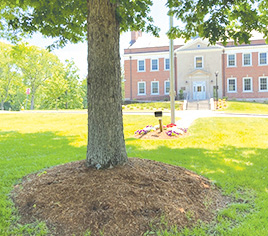Everyone knows mulching is good. What many don’t know is that over-mulching is not good. Over-mulching, once a rarity, has become the norm. What does it look like? Why has this happened? Why is it bad? And how can we fix it?
You’ve probably heard of volcano mulching. The term perfectly describes the look of classic over-mulching. A sloping mound of mulch with a telephone pole like tree trunk descending into the center of it.

Over-mulching comes from good intentions. A mulch ring is good for a tree. Mulch protects trees from mower and weedwacker damage, helps hold in moisture and simulates the natural setting of a forest floor better than a lawn does. But, today’s mulch does not break down as quickly as the mulch of yesteryear, so routinely adding new mulch every year leads to build up, and more is not better.
Trees and shrubs get oxygen through their roots. When the roots are buried beneath more than 3”-4” of mulch they have trouble getting it. Trees adapt by growing new roots higher on the trunk. These roots will eventually strangle the primary roots growing below, leading to the decline and death of the tree.
Fortunately, you can do something about over-mulching. By removing excess mulch you can restore desirable conditions. Small new roots that have developed will dry up when exposed to the air. Bugs and fungi making a happy home in the moist darkness against the trunk of the tree will go elsewhere. And the bonus? You’ll spend less time and money mulching in the future, and your plants will thank you for it.
During the month of July, look for a “De-Mulching” exhibit in front of Town Hall. This visual display of good mulching practices will showcase a side-by-side comparison of two trees. Both have been over-mulched in the past. One tree will remain that way as a reference for what to avoid, the other will be “De-Mulched” to expose the tree’s trunk down to the root flare, the point where the base of the tree widens, and the primary roots can be seen reaching out from the base.
We’ll “de-mulch” the second tree with a public demo and hands-on event later in the season. If you haven’t already de-mulched your yard by then, join us and see first-hand what is going on under all that mulch.